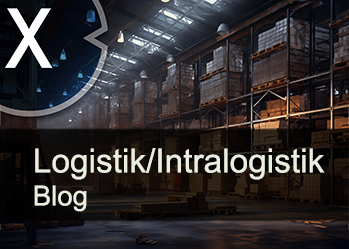Mechanical engineering at its limits? How AI and robotics are solving the biggest challenge in heavy-duty logistics
Xpert pre-release
Language selection 📢
Published on: September 15, 2025 / Updated on: September 15, 2025 – Author: Konrad Wolfenstein

Mechanical engineering at its limits? How AI and robotics are solving the biggest challenge in heavy-duty logistics – Creative image: Xpert.Digital
Intelligent logistics: The secret lever for success in German mechanical engineering
Robots lift tons: How AI is changing heavy-duty logistics forever – How digital twins make heavy transport safer and faster
For a long time, the transport of heavy machine parts, entire systems, or gigantic components was the domain of brute force, meticulous manual planning, and human experience. But this image will soon be a thing of the past. Heavy-duty logistics for mechanical engineering is facing a fundamental paradigm shift, driven by a symphony of data, algorithms, and autonomous technology. Rigid plans and purely mechanical solutions are being replaced by an intelligent, networked ecosystem in which artificial intelligence (AI) and robotics play key roles.
In the age of Industry 4.0, where production processes are highly automated and supply chains are globally interconnected, the demands on logistics are becoming increasingly complex. It's no longer just about moving a heavy load from A to B. What's needed is maximum efficiency, millimeter-precise precision, seamless transparency, absolute safety, and, increasingly, sustainability. This is precisely where new technologies come into play: AI-supported algorithms optimize routes in real time, autonomous robots take over dangerous loading operations, and digital twins simulate the entire transport process before a single wheel rolls.
This article delves deep into the technological revolution in heavy-duty logistics. We explore the technological foundations, from sensors to 5G to edge computing, and show how automation and robotics are transforming physical processes. Learn how digital twins enable virtual test runs, the role AI plays in strategic planning, and how the Internet of Things is creating a self-learning transportation network. Finally, we analyze the far-reaching implications of this development—from new business models and increased sustainability to the critical challenges of safety and implementation. Welcome to the future of heavy-duty logistics.
The future of heavy-duty logistics for mechanical engineering in the age of robotics and AI
Digitalization is fundamentally transforming heavy-duty logistics. While traditional transport methods rely on proven mechanical solutions, new technologies such as artificial intelligence, robotics, and the Internet of Things are enabling unprecedented efficiency and precision in the transport of heavy machinery and equipment. This development is being accelerated by the rapid automation of Industry 4.0, which is placing entirely new demands on the logistics industry.
Artificial intelligence is already revolutionizing transport planning through precise predictive models and automated route optimization. The integration of sensors and intelligent monitoring systems makes it possible to continuously monitor the condition of heavy loads during transport and identify potential problems at an early stage. At the same time, autonomous transport systems and collaborative robots enable unprecedented flexibility in loading and unloading processes.
Heavy-duty logistics is facing a fundamental transformation that goes far beyond mere digitalization. A fully networked ecosystem is emerging in which physical transport processes merge with virtual planning models, and self-learning systems continuously increase efficiency.
Technological foundations of digital transformation
Modern heavy-duty logistics is based on a complex infrastructure of networked systems that goes far beyond traditional GPS tracking solutions. At the heart of this development are Industrial Internet of Things applications that integrate heavy-duty transport vehicles, loading cranes, and handling equipment into an intelligent network.
Sensor technologies play a central role here. Modern heavy-duty transporters are equipped with a variety of monitoring devices that continuously collect data on tilt angles, vibrations, temperature, and structural loads. This information is transmitted in real time to central control systems, where machine learning algorithms can detect anomalies and initiate preventative measures. A practical example is the monitoring of tilt angles in heavy-duty transports, where even minimal deviations from the optimal load distribution pattern can lead to costly damage.
Data processing is increasingly carried out via edge computing systems integrated directly into the transport vehicles. These decentralized computing units enable time-critical decisions to be made without delays caused by network latency. For example, if sensors detect a critical load shift during travel, the edge computing system can immediately initiate countermeasures such as activating hydraulic stabilization systems without relying on external data processing.
5G networks form the communications foundation for these interconnected systems. The extremely low latency of less than one millisecond enables even time-critical control commands to be transmitted wirelessly. This is particularly relevant for coordinated transports of multiple heavy-duty vehicles, where precise synchronization is crucial. The high bandwidth of 5G networks also supports the transmission of high-resolution video data from surveillance cameras, which serve as visual support for remote operators during complex maneuvering procedures.
Predictive maintenance technologies are fundamentally changing the way heavy-duty equipment is maintained. Instead of relying on fixed maintenance intervals, intelligent systems continuously analyze the wear status of critical components such as hydraulic cylinders, wheel bearings, and drivetrains. Machine learning algorithms recognize characteristic patterns that indicate impending failures and trigger preventive maintenance measures before critical damage occurs.
Automation and robotics in heavy-duty logistics
The integration of robotic systems into heavy-duty logistics is taking place at various levels, revolutionizing both physical handling processes and coordination planning tasks. Autonomous mobile robots are increasingly taking over tasks previously performed exclusively by human operators.
In the field of crane control, telepresence robot systems enable the remote control of heavy mobile cranes over long distances. Operators can monitor and control complex lifting operations from central control centers, while high-resolution cameras and force feedback systems ensure precise control. This technology not only reduces personnel costs but also minimizes safety risks during dangerous lifting operations in hard-to-reach areas.
Collaborative robot systems, known as cobots, support assembly and disassembly work on heavy machinery. These systems can precisely position heavy components while collaborating with human technicians. Integrated force sensors ensure that the robots stop immediately if unexpected resistance is encountered, ensuring safe human-machine collaboration.
Route planning for heavy transport is being revolutionized by AI-supported optimization algorithms. These systems consider a variety of factors such as bridge load capacities, road widths, temporary construction sites, traffic density, and weather conditions. Machine learning techniques analyze historical transport data and identify patterns that lead to optimized routes. This not only minimizes transport times but also reduces fuel consumption and wear and tear.
Automated storage systems for heavy machine components utilize specialized robotic cranes and intelligent conveyor systems. These systems can position heavy components weighing several tons with millimeter precision, determining the optimal storage location based on dimensions, weight, and retrieval frequency. Image processing systems automatically recognize the type of stored components and assign them appropriate storage positions.
The coordination of complex transports is increasingly being handled by autonomous planning systems. These AI-based solutions can coordinate multiple heavy-duty transports simultaneously, resolve resource conflicts, and dynamically replan in the event of unforeseen events. For example, if a specialized crane fails due to technical issues, the system can automatically identify alternative equipment and create new schedules for all affected transports.
Digital twins and virtual simulations
Digital twins are revolutionizing the planning and execution of heavy transport operations by creating precise virtual replicas of all components involved. This technology enables complex transport operations to be fully simulated and optimized even before physical execution.
A digital twin of a heavy-duty transport includes not only the transport vehicle and the load, but also the entire transport route with all relevant infrastructure elements. Bridges, underpasses, roundabouts, and inclines are digitally mapped with millimeter precision. CAD data of the machinery being transported is linked to physical properties such as weight distribution, center of gravity, and structural load limits.
The simulation takes into account dynamic factors such as wind loads, road gradients, and curve speeds. Finite element analyses calculate the stress distribution in critical structural elements during various transport phases. These calculations make it possible to identify potential weak points and plan preventative strengthening measures.
Real-time data from sensors during the actual transport is continuously compared with the simulation results. Deviations between the virtual prediction and the real-world measurements trigger automatic recalibrations of the digital twin. These self-learning systems become more precise with each transport and can make increasingly accurate predictions for future operations.
The integration of weather data and traffic forecasts enables dynamic adjustments to transport plans. For example, if strong crosswinds are forecast, the system can suggest alternative routes or schedule delays while waiting for optimal transport conditions.
Virtual training systems based on digital twins make it possible to train crane operators and transport drivers for specific operations without risking real equipment and expensive loads. These immersive simulations can also recreate rare emergency situations that would be too dangerous or costly in reality.
Artificial Intelligence in Planning Optimization
The application of AI technologies in heavy-duty logistics goes far beyond simple route optimization and includes complex decision-making processes that significantly exceed traditional planning methods in terms of efficiency.
Machine learning analyzes historical transport data and identifies subtle patterns undetectable by human planners. These systems can, for example, predict the optimal times of day for heavy goods vehicles to travel on certain road sections based on traffic density, weather conditions, and even seasonal fluctuations. Neural networks process millions of data points from past transports and develop optimization strategies that are continuously refined.
Predictive analytics enable precise forecasting of resource requirements. AI systems can analyze when specific specialized cranes, support vehicles, or qualified operators are needed and automatically make reservations. This forward-looking resource planning reduces waiting times and minimizes costly empty runs of specialized equipment.
Dynamic price optimization is enabled by AI-based algorithms that analyze market conditions, demand fluctuations, and operating costs in real time. These systems can automatically generate price quotes that are both competitive and profitable while optimizing capacity utilization.
The integration of external data sources such as traffic information, weather data, and economic indicators enables AI systems to make even more precise predictions. For example, if a major construction site is announced, the system can identify alternative routes months in advance and make appropriate capacity planning.
Autonomous negotiation systems can automatically negotiate transport orders with customers, taking into account factors such as transport complexity, available resources, and strategic customer relationships. These AI agents can learn which negotiation strategies are successful with different customer types and adapt their approaches accordingly.
Connected transport systems and IoT integration
The Internet of Things is transforming heavy-duty logistics by seamlessly connecting all components involved into an intelligent, self-organizing ecosystem. This comprehensive networking enables unprecedented transparency and control over complex transport operations.
Intelligent sensor networks continuously monitor all critical parameters during transport. Acceleration measurements detect vibrations and shocks that could indicate damage to sensitive machine components. Temperature sensors monitor both the ambient temperature and the heating of critical transport elements such as hydraulic systems and wheel bearings. Inclination sensors detect even minimal deviations from the optimal load position and trigger automatic corrections as needed.
Communication between different transport vehicles takes place via dedicated vehicle-to-vehicle protocols. In coordinated transports involving multiple heavy-duty vehicles, these systems can synchronize speeds, automatically adjust headways, and initiate collective braking maneuvers in emergencies. GPS data is combined with relative position measurements to enable centimeter-precise coordination.
Infrastructure-to-vehicle communication integrates heavy goods vehicles into intelligent transport infrastructure systems. Traffic lights can automatically respond to incoming heavy goods vehicles and provide optimized switching cycles. Bridges and tunnels can communicate their structural parameters, such as maximum load capacity and current traffic load, to passing vehicles, thus avoiding critical situations.
Blockchain technologies ensure the integrity and traceability of all transport data. Every sensor reading, every route change, and every interaction with the infrastructure is stored in immutable data blocks. This technology is particularly relevant for high-value or safety-critical transports where comprehensive documentation is required.
Edge computing nodes in transport vehicles process large amounts of data locally, reducing the dependence on continuous network connectivity. These systems can make autonomous decisions and maintain critical safety functions even during temporary communication interruptions.
Your container high-bay warehouse and container terminal experts

Container terminal systems for road, rail, and sea in the dual-use logistics concept of heavy-duty logistics - Creative image: Xpert.Digital
In a world characterized by geopolitical upheavals, fragile supply chains, and a new awareness of the vulnerability of critical infrastructure, the concept of national security is undergoing a fundamental reassessment. A state's ability to ensure its economic prosperity, the supply of its population, and its military capability increasingly depends on the resilience of its logistics networks. In this context, the term "dual-use" is evolving from a niche category of export control to a overarching strategic doctrine. This shift is not merely a technical adaptation, but a necessary response to the "turning point" that requires the profound integration of civilian and military capabilities.
Suitable for:
Digital platforms & predictive maintenance as efficiency boosters for mechanical engineers
Sustainability and energy efficiency
The integration of sustainability aspects into heavy-duty logistics is being significantly advanced by digital technologies and enables a significant reduction of the ecological footprint while simultaneously saving costs.
Electrification of heavy-duty vehicles is made practical by intelligent energy management systems. AI-based algorithms optimize battery usage based on route profiles, load weights, and topographical conditions. Regenerative braking systems are strategically deployed to recover energy when driving downhill. Predictive charging strategies plan optimal charging stops based on the availability of high-power charging stations and current electricity prices.
Hybrid drive systems intelligently combine different energy sources. Fuel cells can be used for long-distance journeys, while battery systems maximize efficiency at low speeds in urban areas. Hydrogen filling stations are networked via IoT systems, allowing real-time availability and pricing.
Fuel efficiency optimization for conventional drives is achieved through precise analysis of driving patterns and automatic adjustment of engine parameters. AI systems learn optimal acceleration and braking patterns for different transport scenarios and can support drivers with adaptive cruise control systems. Aerodynamic optimization is achieved through automatically adjustable wind deflectors and side skirts that configure themselves based on wind direction and speed.
Route optimization takes environmental factors such as CO2 emissions and noise pollution into account. Alternative routes are evaluated not only based on time and cost criteria, but also on their environmental impact. Nighttime journeys can be planned automatically to minimize noise pollution in residential areas.
Circular economy principles are supported by digital platforms that identify and combine return freight. When a heavy-duty transport brings a machine to a destination, AI systems can automatically search for return freight, avoiding empty runs. These platforms can also identify temporary storage needs and optimize transport capacity for multiple customers.
Security and cyber protection
The increasing digitalization of heavy-duty logistics creates new security challenges that encompass both physical and digital aspects and require special protective measures.
Cybersecurity is becoming a critical factor, as networked transport systems represent potential targets for cybercriminals. Tampering with control systems could have catastrophic consequences if, for example, crane controls or hydraulic stabilization systems are compromised. Multi-layered security architectures with end-to-end encryption, biometric authentication, and continuous monitoring of network activity are therefore essential.
Anomaly detection through machine learning identifies suspicious activity in connected transportation systems. These systems learn normal behavior patterns and can immediately detect anomalous activity. For example, if unusual control commands are sent to critical systems, automatic safety mechanisms can block them and trigger an alarm.
Physical security is enhanced by intelligent surveillance systems. AI-powered video analytics can automatically detect suspicious activity around parked heavy goods vehicles. Motion detectors and vibration sensors register unauthorized access and trigger both local alarms and notifications to security services.
Backup systems ensure functionality even in the event of partial system failures. Critical control functions are designed redundantly so that if the primary systems fail, they can automatically switch to manual or alternative control modes. Offline navigation systems can maintain basic transport functions even in the event of a total communication link failure.
Compliance with safety standards such as IEC 62443 is ensured through automated monitoring and documentation systems. These systems log all safety-relevant events and automatically generate compliance reports. Regular security updates are managed centrally and automatically distributed to all networked systems.
Emergency protocols are continuously updated and optimized by AI systems. These systems learn from past incidents and develop more effective response strategies. In critical situations, automatic emergency calls can be made with precise location data and situation descriptions.
Challenges and implementation strategies
The transformation to digital heavy-duty logistics brings with it complex technical, organizational and economic challenges that require well-thought-out implementation strategies.
The integration of different technology platforms represents one of the greatest technical challenges. Existing vehicle fleets, crane control systems, and logistics systems often originate from different manufacturers and use incompatible communication protocols. The development of middleware solutions and standardized interfaces is therefore crucial for successful integration. API-based architectures enable incremental modernization without having to completely replace existing systems.
Finding and training qualified personnel to handle new technologies poses significant challenges for many companies. The combination of traditional transportation knowledge and modern IT skills is rarely available on the job market. Systematic continuing education programs and close cooperation with educational institutions are necessary to close this skills gap.
High investment costs for digitalization can be particularly overwhelming for smaller companies. Cloud-based software-as-a-service models and hardware leasing options can reduce these hurdles. Phased implementation strategies make it possible to start with critical areas and digitize additional areas after successful validation.
Data protection and security require special attention, as sensitive information about transport routes, cargo, and customers must be protected. Local data processing through edge computing and encrypted communication are key components in this process. Clear data policies must define which information is shared and which remains local.
Regulatory uncertainties regarding autonomous transport systems and AI-based decision-making complicate investment decisions. Close cooperation with regulators and participation in pilot projects can help create legal clarity and develop standards.
Change management is crucial for the successful introduction of new technologies. Employees must be involved in planning processes early on, and the benefits of digitalization must be clearly communicated. Gradual introductions with adequate training phases reduce resistance and increase acceptance.
Future prospects and market development
Heavy-duty logistics is at the beginning of a fundamental transformation that will be accelerated in the coming years by technological breakthroughs and changing market requirements.
Autonomous heavy transport systems are gradually becoming a reality, starting with controlled environments such as industrial sites and ports. The first fully autonomous systems for standardized transport routes between fixed points will be operational within the next five years. The technology will then expand to more complex scenarios, with human operators initially acting as safety backup.
Artificial intelligence will increasingly act proactively rather than reactively. Future AI systems will not only react to current situations but will also incorporate market trends, technological developments, and even geopolitical events into their planning. These systems could, for example, automatically reserve capacity for anticipated infrastructure projects or develop alternative supply chains before disruptions occur.
The integration of quantum computing will solve optimization problems that are currently unsolvable. Complex multi-objective functions with thousands of variables can then be optimized in real time, achieving previously unattainable efficiency gains. Route optimization for hundreds of simultaneous transports, taking all relevant factors into account, will become standard practice.
Sustainability is evolving from a nice-to-have to a competitive advantage. Regulatory requirements are becoming more stringent, while customers are increasingly demanding carbon-neutral transportation. Companies that invest early in sustainable technologies will gain market advantages. Hydrogen-based drives could become particularly relevant for heavy-duty applications.
New business models are emerging through platform economies and shared economy approaches. Transportation-as-a-Service is also becoming relevant for heavy-duty logistics, providing companies with on-demand access to specialized transport capacity. Digital marketplaces will automatically match supply and demand, enabling optimal resource allocation.
The convergence of different technologies will enable entirely new applications. Augmented reality could give crane operators X-ray vision through obstacles, while brain-computer interfaces enable intuitive control of complex systems. 6G networks will enable holographic telepresence for remote operations.
Impact on the mechanical engineering industry
The digitalization of heavy-duty logistics is fundamentally changing the mechanical engineering industry and creating new opportunities for efficiency improvements and customer service.
Shortened delivery times through optimized transport planning enable machine manufacturers to respond more flexibly to customer requests. Just-in-time deliveries of heavy machine components are made possible by precise forecasting models that seamlessly coordinate production cycles, transport times, and installation dates. Customers benefit from reduced project lead times and can better plan their own investment cycles.
New service business models are emerging through the continuous monitoring of installed machines. Predictive maintenance is being extended from the machine location to the entire transport route, with the condition of critical components being monitored during transport. This allows problems to be identified and resolved before the machine reaches its destination.
Global supply chains are becoming more transparent and resilient. Machine manufacturers can track the location of their products in real time and respond proactively to disruptions. Alternative transport routes and backup plans are automatically activated when primary routes are blocked. This transparency also enables better communication with end customers about delivery status and expected arrival times.
Cost optimization through intelligent logistics reduces overall costs for machine manufacturers. Optimized route planning, reduced empty runs, and preventative maintenance significantly reduce transportation costs. These savings can either be used to increase margins or passed on to customers as a competitive advantage.
Quality improvement through continuous monitoring during transport ensures that sensitive machinery arrives in optimal condition. Sensors detect harmful vibrations or extreme temperatures and trigger protective measures. This quality assurance reduces warranty costs and improves customer satisfaction.
New opportunities for collaboration are emerging through networked platforms. Machine manufacturers can collaborate more closely with logistics service providers and develop joint optimizations. Shared intelligence enables the sharing of best practices and the development of continuous improvements.
The transformation of heavy-duty logistics through robotics and artificial intelligence marks a turning point in industrial development. While the technological foundations are already in place, successful implementation will depend on companies' ability to intelligently integrate people, processes, and technologies. Companies that meet this challenge will not only benefit from significant efficiency gains and cost reductions but will also be able to develop new business models that were unthinkable in traditional logistics.
The future belongs to networked, intelligent systems that autonomously make optimal decisions while pursuing both economic and ecological goals. This development will transform heavy-duty logistics from a reactive service provider to a proactive partner of the mechanical engineering industry, not just providing transport services but becoming an integral part of the value chain.
Advice - planning - implementation
I would be happy to serve as your personal advisor.
Head of Business Development
Advice - planning - implementation
I would be happy to serve as your personal advisor.
contact me under Wolfenstein ∂ Xpert.digital
call me under +49 89 674 804 (Munich)























